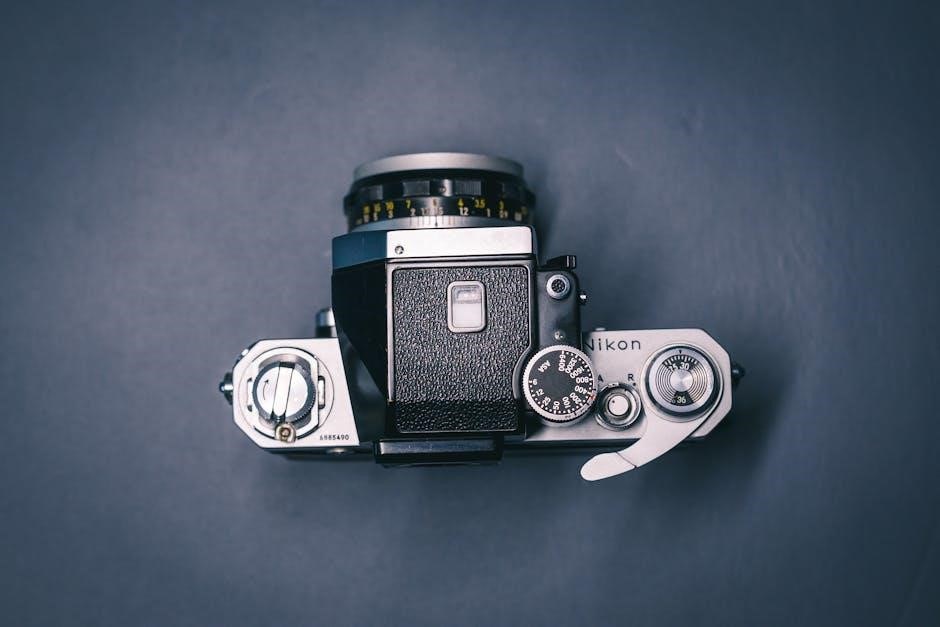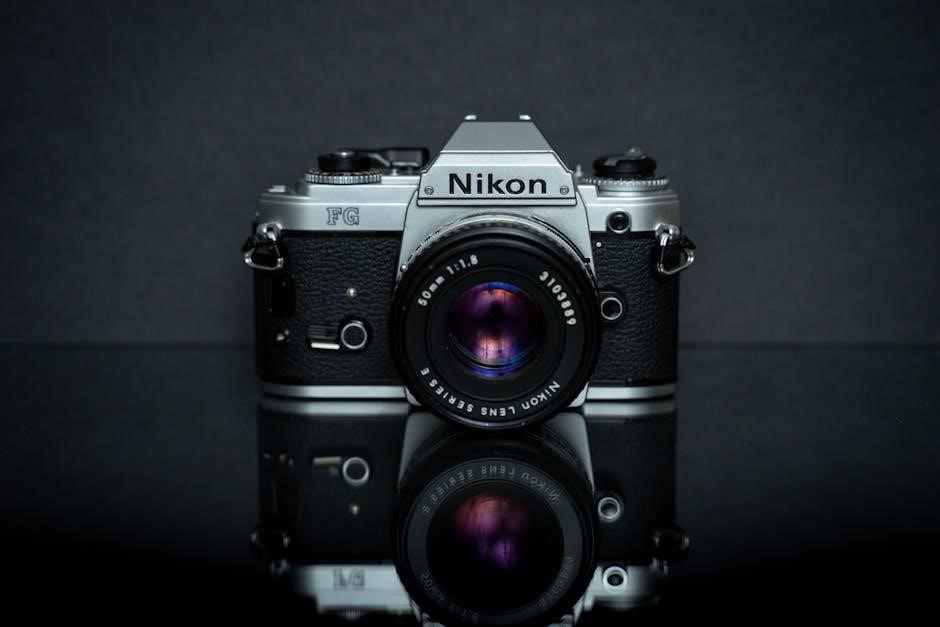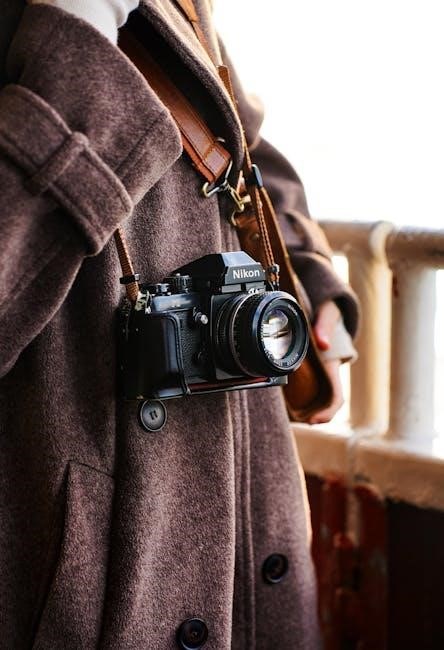This manual provides comprehensive guidance for mastering the Nikon Ftn camera, detailing its features, operation, and maintenance. It ensures optimal use of the camera’s capabilities, offering detailed instructions and troubleshooting tips to enhance your photography experience. Resources like Mike Butkus’ manuals and online guides further support users in understanding and utilizing the Nikon Ftn effectively.
1.1 Overview of the Nikon Ftn Camera
The Nikon Ftn is a 35mm single-lens reflex (SLR) camera renowned for its durability and versatility. Designed for both professional photographers and enthusiasts, it features interchangeable lenses and a robust build quality. The camera incorporates the Photomic FTn finder, which includes a built-in light meter for precise exposure control. Its mechanical design ensures reliability without relying on batteries for core functions. The Ftn model is part of Nikon’s iconic F series, which has been a benchmark in photography since its introduction. With its intuitive controls and advanced features for its time, the Nikon Ftn remains a favorite among collectors and photographers who appreciate its blend of tradition and innovation.
1.2 Importance of the Manual for Optimal Usage
The Nikon Ftn manual is an essential guide for unlocking the camera’s full potential. It provides detailed instructions on operating the camera, including loading film, setting ISO, and using the built-in light meter. The manual also covers maintenance tips to ensure longevity and troubleshooting common issues. By understanding the camera’s features through the manual, photographers can achieve precise control over exposure and focus. Additionally, it serves as a reference for compatible lenses and accessories, enhancing versatility. Whether for a professional or enthusiast, the manual is crucial for mastering the Nikon Ftn and optimizing its performance in various photography scenarios. It ensures users can fully utilize the camera’s advanced features and maintain it properly for years of reliable service.

Historical Background and Development
The Nikon Ftn, introduced in the 1970s, evolved from the iconic Nikon F series, building on its legacy with improved features and mechanical precision. It became a favorite among professionals for its durability and reliability, marking a significant milestone in Nikon’s history. The Ftn model incorporated advancements in design and functionality, solidifying Nikon’s reputation as a leader in photography equipment. Its development reflected the company’s commitment to innovation, catering to the growing demands of photographers worldwide. This camera remains a testament to Nikon’s enduring influence in the photography industry.
2.1 The Evolution of the Nikon F Series
The Nikon F series, introduced in 1959, revolutionized 35mm SLR photography with its durability and interchangeable components. The Ftn, released in the early 1970s, represented a refinement of this legacy, incorporating advancements in metering and ergonomics. Building on the success of earlier models, the Ftn introduced the Photomic finder, which integrated a CdS exposure meter for precise light measurement. This innovation enhanced usability and accuracy, making it a favorite among professional photographers. The F series’ evolution reflected Nikon’s commitment to meeting the demands of a growing photography community, ensuring the Ftn became a cornerstone of photographic history. Its design and functionality solidified Nikon’s reputation as a leader in camera manufacturing, paving the way for future innovations.
2.2 Key Features and Innovations in the Ftn Model
The Nikon Ftn model introduced several groundbreaking features, including the Photomic FTn finder, which incorporated a CdS exposure meter for precise light measurement. This innovation allowed for more accurate exposure control, enhancing the camera’s usability. The Ftn also featured improved shutter speed coupling, ensuring seamless synchronization with flash units. Its robust construction and ergonomic design made it a favorite among professionals. The camera’s compatibility with a wide range of lenses and accessories further expanded its versatility. These advancements solidified the Ftn’s reputation as a reliable and innovative tool for photographers, blending tradition with cutting-edge technology to meet the evolving needs of the photography community.
Technical Specifications of the Nikon Ftn
The Nikon Ftn features a robust build, interchangeable lenses, and a CdS exposure meter. It supports a wide range of shutter speeds and aperture settings, ensuring precise control over exposures. The camera’s compatibility with various accessories, including the Photomic FTn finder, enhances its versatility for professional and enthusiast photographers alike.
3.1 Key Specifications and Hardware Details
The Nikon Ftn is a mechanically robust camera with interchangeable lenses, featuring a 35mm film format. It boasts a durable brass and chrome-plated body, weighing approximately 745 grams without the lens. The camera is equipped with a horizontally traveling focal-plane shutter, offering speeds from 1/1000th of a second to 1 second, plus a Bulb setting. The viewfinder is interchangeable, with the Photomic FTn finder being a popular choice, incorporating a CdS exposure meter for precise light measurement. The lens mount supports Nikkor lenses, ensuring compatibility with a wide range of optics. The camera’s manual operation and mechanical design make it a reliable tool for photographers seeking precision and control over their craft.
3.2 Shutter Speed and Aperture Range
The Nikon Ftn features a mechanically controlled focal-plane shutter, offering speeds from 1/1000th of a second to 1 second, plus a Bulb setting for extended exposures. The aperture range varies depending on the lens used, typically spanning from f/1.4 to f/32. The camera’s shutter and aperture controls are designed for precise manual operation, allowing photographers to fine-tune their exposures. The Ftn also incorporates a match-needle system in its Photomic FTn finder, enabling users to align the needle with the desired aperture and shutter speed for accurate exposure. This system ensures compatibility with a wide range of Nikkor lenses, making the Ftn versatile for various photographic applications. The manual controls and robust design make it a reliable choice for photographers seeking creative control over their work.

Operating the Nikon Ftn Camera
Mastering the Nikon Ftn involves loading film, advancing frames, and setting ISO. Use the built-in light meter for precise exposures, adjusting shutter and aperture as needed for optimal results.
4.1 Loading and Advancing Film
Loading film into the Nikon Ftn is a straightforward process. Open the camera back by pulling the release latch. Insert the film cartridge, ensuring it aligns with the spool. Gently pull the film leader to secure it in place. Close the back and advance the film to the first frame using the rapid advance lever. Ensure the film counter resets and the meter is ready. Always check the frame counter to confirm the film is loaded correctly. Properly advancing the film ensures sharp, well-exposed images. Refer to the manual for detailed steps to avoid errors during the process.
4.2 Setting the ISO and Exposure Compensation
Setting the ISO on the Nikon Ftn is done by adjusting the film speed dial located on the shutter speed dial. Match the dial to the film’s ISO rating for accurate exposure. Exposure compensation is achieved by adjusting the aperture or shutter speed based on the built-in light meter’s readings. For flash photography, refer to the Guide Number system to determine the correct F-number and shutter speed combination. Ensure the ISO setting matches the film loaded to maintain proper exposure. Adjustments should be made carefully to avoid overexposure or underexposure. Always check the light meter for precise readings before capturing images. Proper ISO and exposure settings are crucial for achieving optimal results with the Nikon Ftn.
4.3 Using the Built-In Light Meter
The Nikon Ftn features a built-in CdS exposure meter, providing accurate light readings to help achieve perfect exposures. To use the light meter, ensure the camera is set to the correct ISO and film speed. Align the meter’s needle with the center mark by adjusting the aperture or shutter speed. The meter measures light through the lens, offering precise readings. For optimal results, use the meter in various lighting conditions to fine-tune your settings. The light meter is integrated with the Photomic FTn viewfinder, allowing seamless adjustments. Always check the meter before capturing images to ensure balanced exposures. Proper use of the light meter enhances the quality of your photographs, making it an essential tool for mastering the Nikon Ftn.

The Photomic FTn Finder
The Photomic FTn Finder is an advanced eye-level viewfinder with a built-in CdS exposure meter, designed for precise through-the-lens metering. It enhances composition and exposure accuracy, making it an essential accessory for the Nikon Ftn camera.

5.1 Understanding the Photomic FTn Viewfinder
The Photomic FTn Viewfinder is a sophisticated eye-level prism finder designed for the Nikon Ftn camera. It features a built-in CdS exposure meter, enabling precise through-the-lens (TTL) metering. The viewfinder provides a clear, bright view of the scene, with a 60/40 center-weighted metering pattern for accurate exposure calculations. It also includes a brightline frame to help compose shots effectively. The shutter speed scale is visible in the viewfinder, allowing quick adjustments without taking the eye off the subject. This feature-rich design makes the Photomic FTn Viewfinder an essential tool for achieving optimal exposures and enhancing the overall shooting experience with the Nikon Ftn.

5.2 Adjusting and Using the Viewfinder

Adjusting the Photomic FTn Viewfinder ensures optimal comfort and accuracy. The diopter adjustment allows users to fine-tune the viewfinder to their eyesight for sharp focus. To adjust, turn the diopter ring until the viewfinder image is clear. The built-in CdS exposure meter provides precise readings, displayed as a needle in the viewfinder. Match the needle to the desired aperture and shutter speed for proper exposure. The viewfinder also features a brightline frame, aiding in composition. For accurate metering, ensure the camera is set to the correct ISO and that the lens is properly coupled. Regular cleaning of the viewfinder and eyepiece ensures unobstructed viewing. Proper use of the viewfinder enhances shooting efficiency and image quality, making it an indispensable tool for photographers using the Nikon Ftn.

Accessories and Compatible Equipment
The Nikon Ftn supports a range of accessories, including interchangeable lenses, flash units, and the Photomic FTn viewfinder. These enhance functionality and customization for photographers.
6.1 Lenses Compatible with the Nikon Ftn
The Nikon Ftn is compatible with a wide range of lenses, including Nikkor AI and pre-AI lenses, which are renowned for their optical quality and versatility. The camera’s F-mount system ensures compatibility with numerous lenses, from wide-angle to telephoto, catering to various photographic needs. Popular options include the Nikkor 50mm f/1.4, 35mm f/2, and 105mm f/2.5, which are highly regarded for their sharpness and performance. Additionally, the Ftn supports older non-AI lenses with manual metering, offering flexibility for photographers who prefer classic optics. Third-party lenses from brands like Vivitar and Tokina are also compatible, providing affordable alternatives. This extensive lens compatibility makes the Nikon Ftn a versatile tool for both professional and enthusiast photographers, allowing for a wide range of creative possibilities.

6.2 Flash and Other Accessories
The Nikon Ftn supports various flash units, including the Nikon Speedlight series, for enhanced lighting control. The camera features a flash synchronization system, allowing precise timing with the shutter. Users can refer to the Guide Number system for calculating optimal flash exposure. Additionally, the Ftn is compatible with the Photomic FTn finder, which incorporates a CdS exposure meter for accurate light measurement. Other accessories include remote shutter releases, tripod adapters, and lens hoods, which enhance functionality and convenience. These accessories expand the camera’s capabilities, making it a versatile tool for professional and amateur photographers alike. Proper use of these accessories ensures superior image quality and versatility in different shooting conditions.
Maintenance and Troubleshooting
Regular cleaning and lubrication of moving parts ensure smooth operation. Refer to repair manuals for detailed maintenance procedures. Address common issues like shutter speed inaccuracies promptly for optimal performance.
7.1 Cleaning and Maintaining the Camera
Regular maintenance is crucial for the Nikon Ftn’s longevity. Clean the exterior with a soft cloth, avoiding harsh chemicals. The viewfinder and lens should be wiped gently with a microfiber cloth. Internal mechanisms require periodic lubrication, as outlined in repair manuals. Shutter speed accuracy can be verified and adjusted using the guide number system. Proper care prevents dust buildup and ensures smooth operation. Refer to the repair manual for detailed procedures to maintain optimal performance and extend the camera’s lifespan. Regular checks and professional servicing are recommended for complex repairs. By following these steps, you can preserve the camera’s functionality and ensure it remains reliable for years. Proper maintenance is key to capturing high-quality images consistently.
7.2 Common Issues and Solutions
Common issues with the Nikon Ftn include improper shutter speed coupling and flash synchronization. To resolve these, refer to the guide number system for accurate flash exposure. Viewfinder fogging can occur; clean it with a microfiber cloth. Mirror alignment issues may arise, requiring professional adjustment. For exposure meter inaccuracies, recalibrate using the CdS exposure meter. Lubrication of mechanical parts should be done by experts to avoid damage. If the shutter sticks, avoid forced advancement and consult a repair manual. Regular maintenance, as outlined in the manual, prevents many of these issues; Addressing these problems ensures optimal performance and image quality. Proper care and timely solutions are essential for extending the camera’s lifespan and reliability. Always follow the manual’s troubleshooting guide for best results.
The Legacy of the Nikon Ftn
The Nikon Ftn left a lasting impact on photography, influencing both professionals and enthusiasts. Its durability and innovative features made it a favorite among collectors and modern photographers alike.
8.1 Impact on Photography and Film Industry
The Nikon Ftn significantly influenced the photography and film industry with its reliability and innovative features. Professionals widely adopted it for its precision and durability, making it a staple in both still photography and cinematic applications. Its interchangeable lenses and advanced metering system allowed for greater creative control, enabling photographers to capture high-quality images in various conditions. The camera’s popularity extended to educational institutions, where it became a tool for teaching photography techniques. Its impact is evident in the work of renowned photographers and filmmakers who relied on the Ftn for their projects. The Nikon Ftn’s legacy continues to be celebrated for its contribution to the evolution of photography and its enduring influence on the industry.

8.2 Collectibility and Modern Usage
The Nikon Ftn has become a sought-after collector’s item due to its historical significance and enduring build quality. Many photographers and enthusiasts still use it today, appreciating its mechanical precision and the unique experience of shooting with film. Its compatibility with a wide range of lenses and accessories makes it a versatile tool for both collectors and active photographers. The camera’s durability and timeless design have ensured its relevance, even in the digital age. As a result, the Nikon Ftn remains a cherished possession for those who value analog photography and the creative process it embodies. Its collectibility and continued use underscore its lasting impact on the world of photography.

